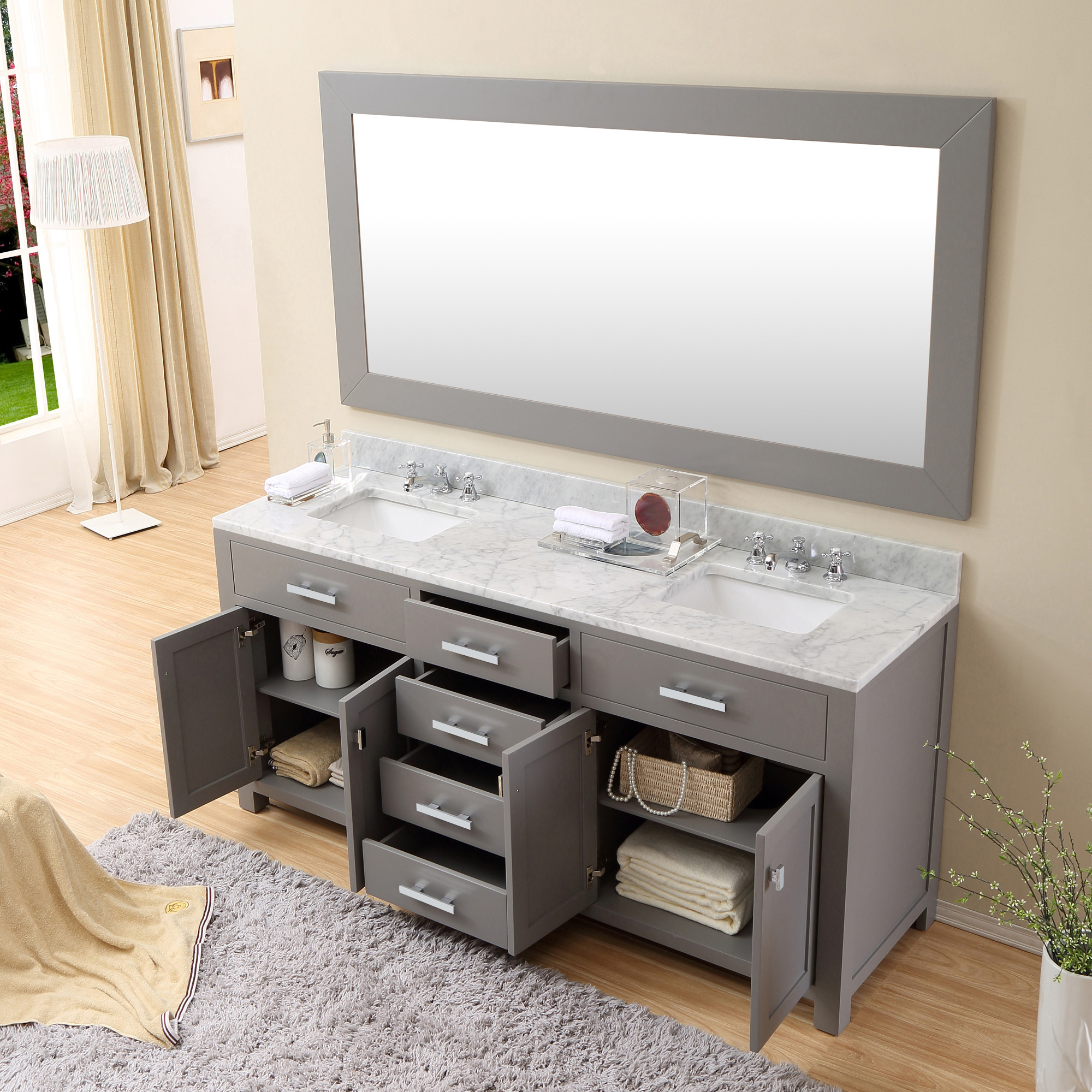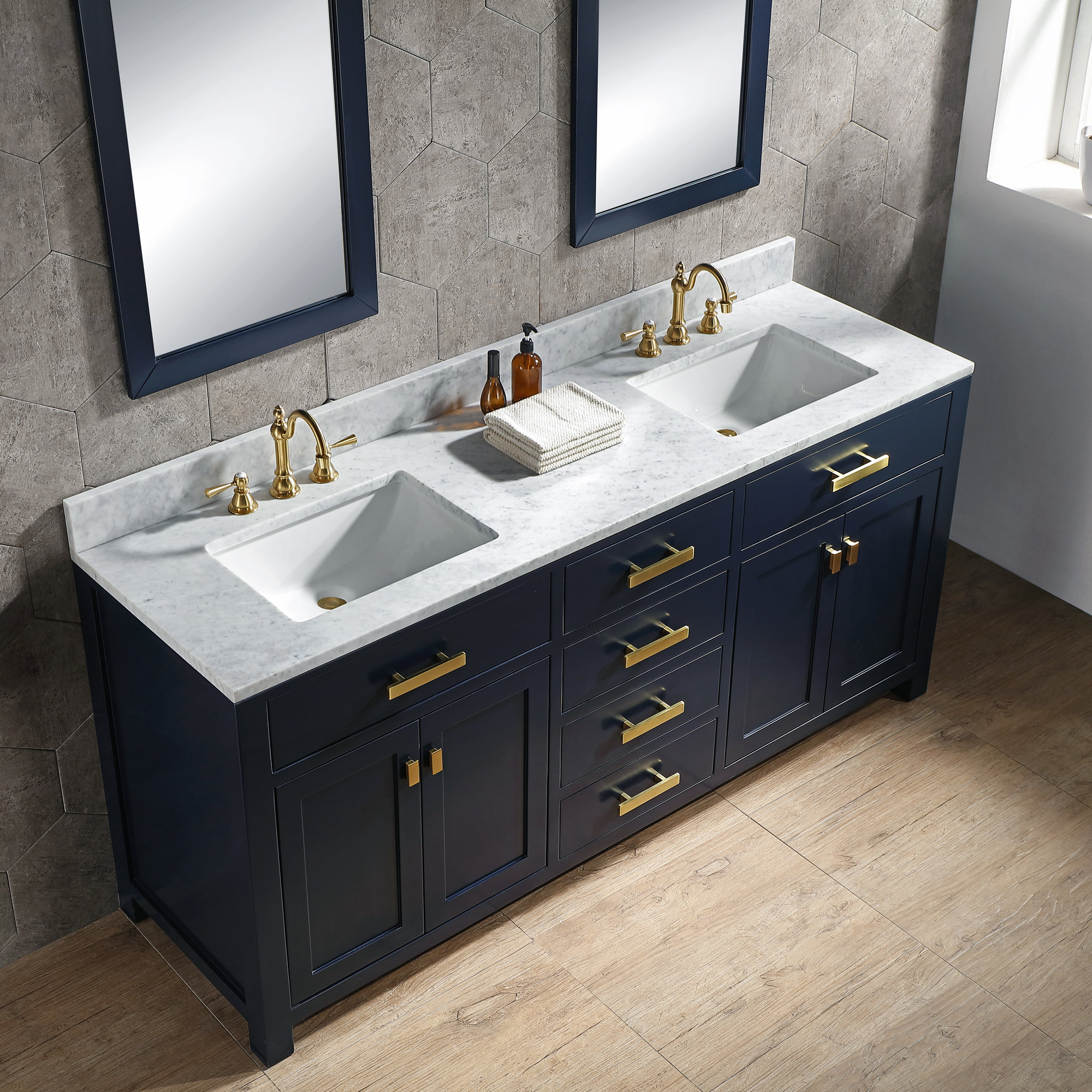Understanding the 72-Inch Vanity Landscape

A 72-inch bathroom vanity is a popular choice for larger bathrooms, offering ample storage and counter space. This size provides a spacious and functional focal point for the room, making it a preferred option for homeowners looking to create a luxurious and practical bathroom environment.
Popularity of 72-Inch Vanities
The popularity of 72-inch vanities stems from their ability to accommodate multiple users comfortably. They provide ample counter space for personal care items and makeup, as well as ample storage for toiletries and towels. The generous size allows for a more spacious and luxurious feel in the bathroom, catering to the needs of larger families or those who enjoy having extra space.
Advantages and Disadvantages of a 72-Inch Vanity
Advantages
- Ample Storage: 72-inch vanities offer a significant amount of storage space, allowing for the organization of various bathroom essentials.
- Spacious Countertop: The large countertop provides ample space for multiple users, ensuring a comfortable and convenient experience.
- Enhanced Aesthetics: The size of a 72-inch vanity creates a grand and luxurious feel in the bathroom, adding to the overall aesthetic appeal.
- Versatility: 72-inch vanities can accommodate a variety of sink styles and configurations, offering flexibility in bathroom design.
Disadvantages
- Space Requirements: A 72-inch vanity requires a larger bathroom space to accommodate its size effectively.
- Higher Cost: 72-inch vanities are generally more expensive than smaller vanities due to their larger size and more complex construction.
- Installation Challenges: Installing a 72-inch vanity can be more challenging than installing a smaller vanity, requiring careful planning and possibly professional assistance.
Common Features and Functionalities
72-inch vanities typically incorporate various features and functionalities to enhance their practicality and aesthetics. These features may include:
- Multiple Drawers and Cabinets: To accommodate the increased storage needs, 72-inch vanities often feature multiple drawers and cabinets, offering ample space for organizing various items.
- Double Sinks: To facilitate multiple users, many 72-inch vanities include double sinks, providing a convenient and efficient setup for families or couples.
- Integrated Lighting: To enhance visibility and create a more sophisticated ambiance, 72-inch vanities often incorporate integrated lighting options, such as under-cabinet lights or mirror lights.
- Soft-Close Drawers and Doors: To provide a quiet and luxurious experience, many 72-inch vanities feature soft-close drawers and doors, ensuring smooth operation and preventing slamming.
- Durable Materials: 72-inch vanities are typically constructed from durable materials such as solid wood, engineered wood, or laminate, ensuring longevity and resistance to wear and tear.
Examples of 72-Inch Vanity Styles
72-inch vanities come in a wide range of styles to complement different bathroom aesthetics. Here are some examples:
- Traditional Style: Traditional vanities often feature ornate carvings, intricate details, and a classic design aesthetic. They are typically crafted from solid wood and often include decorative elements like crown molding and raised panels.
- Modern Style: Modern vanities emphasize clean lines, minimalist design, and sleek finishes. They are often made from materials like lacquered wood, metal, or glass, and feature geometric shapes and bold colors.
- Contemporary Style: Contemporary vanities blend modern elements with traditional influences, creating a stylish and sophisticated look. They may feature a mix of materials, textures, and colors, and often incorporate innovative design features.
- Rustic Style: Rustic vanities evoke a sense of natural beauty and warmth. They are typically made from reclaimed wood, natural stone, or other rustic materials, and often feature distressed finishes or rough textures.
- Transitional Style: Transitional vanities bridge the gap between traditional and modern styles, creating a timeless and versatile look. They often feature a combination of classic and contemporary elements, resulting in a balanced and elegant design.
Choosing the Right 72-Inch Vanity Without a Top

Selecting a 72-inch vanity without a top is an exciting step in your bathroom renovation journey. With so many options available, understanding the key factors to consider will ensure you choose a vanity that perfectly complements your style and needs.
Vanity Base Material
The material of your vanity base will significantly impact its durability, aesthetics, and price.
- Solid Wood: Known for its natural beauty and timeless appeal, solid wood vanities offer exceptional durability and can be refinished over time. Popular choices include oak, cherry, maple, and walnut.
- Engineered Wood: This cost-effective option is made from wood byproducts, offering a sturdy and affordable alternative. Engineered wood vanities are often finished to mimic the appearance of solid wood.
- Laminate: Durable and water-resistant, laminate vanities are an excellent choice for high-traffic areas. They come in a wide range of colors and patterns, making them a versatile option.
- Metal: Metal vanities, typically constructed from stainless steel or aluminum, offer a modern and sleek aesthetic. They are highly durable and resistant to moisture.
Vanity Base Finishes
The finish of your vanity base adds the final touch to its overall look and feel.
- Painted: Painted vanities offer a wide array of colors, allowing you to match your existing décor or create a bold statement. Popular finishes include white, gray, and black.
- Stained: Stained vanities showcase the natural beauty of wood, enhancing its grain patterns and creating a warm and inviting ambiance. Popular stains include cherry, walnut, and mahogany.
- Distressed: Distressed finishes add a touch of rustic charm and character to your bathroom. They often feature chipped paint, worn edges, and other signs of age.
- Glossy: Glossy finishes create a sleek and modern look, reflecting light and adding a touch of sophistication.
- Matte: Matte finishes offer a subtle and understated aesthetic, providing a soft and velvety appearance.
Storage Space and Drawer Configuration
Storage space is crucial for a functional bathroom vanity. Consider the size of your bathroom and your storage needs when choosing a vanity base.
- Number of Drawers: The number of drawers will determine the amount of storage space available. Consider the size of your bathroom and the amount of storage you require.
- Drawer Size: Larger drawers are ideal for storing bulky items, while smaller drawers are perfect for organizing smaller items.
- Drawer Configuration: Some vanities feature soft-close drawers, which provide a quiet and smooth closing experience. Others may have drawers with pull-out organizers, making it easier to access and organize your belongings.
Factors to Consider When Choosing a Vanity Base Without a Top, 72 bathroom vanity without top
When choosing a vanity base without a top, consider these key factors:
- Sink Size and Style: Ensure the vanity base is compatible with your desired sink size and style.
- Faucet Placement: Choose a vanity base with a faucet hole configuration that aligns with your chosen faucet style.
- Countertop Material: Consider the countertop material you plan to use and ensure it complements the vanity base.
- Overall Style: Choose a vanity base that complements the overall style of your bathroom.
- Budget: Set a budget for your vanity base and stick to it.
Designing a Custom Vanity Top: 72 Bathroom Vanity Without Top

A 72-inch vanity without a top offers a blank canvas for creating a truly personalized bathroom space. Choosing the right countertop material and sink style can elevate your vanity from functional to fabulous.
Countertop Materials
Selecting the perfect countertop material is essential for both functionality and aesthetics. Here’s a comparison of popular options:
| Material | Pros | Cons | Cost (Approximate) |
|---|---|---|---|
| Granite | Durable, scratch-resistant, heat-resistant, unique patterns | Porous, requires sealing, can be heavy | $70-$150 per square foot |
| Marble | Elegant, luxurious, cool to the touch | Soft, easily scratched, stains easily, requires regular sealing | $80-$200 per square foot |
| Quartz | Non-porous, durable, scratch-resistant, wide range of colors and patterns | Can be more expensive than granite or marble | $60-$120 per square foot |
| Engineered Stone | Durable, stain-resistant, heat-resistant, wide range of colors and patterns | Can be more expensive than natural stone | $50-$100 per square foot |
| Laminate | Affordable, easy to clean, wide range of colors and patterns | Not as durable as natural stone, can be susceptible to scratches and heat | $20-$50 per square foot |
Choosing the Right Sink Style
The sink you choose should complement the size and style of your 72-inch vanity. Consider these factors:
- Undermount Sink: This sleek and modern style seamlessly integrates with the countertop, creating a clean and contemporary look. It’s ideal for a minimalist aesthetic and provides ample counter space.
- Vessel Sink: This unique and stylish option sits above the countertop, adding a touch of elegance and sophistication. It’s perfect for a statement piece and can be found in a variety of materials and designs.
- Drop-in Sink: This traditional style sits directly on the countertop, offering a classic and timeless look. It’s a practical and affordable choice that’s easy to install.
- Double Sink: For larger bathrooms, a double sink provides convenience and functionality, especially for families or couples. It can be either undermount or drop-in style.
Designing a Bathroom Layout
A 72-inch vanity without a top can be incorporated into various bathroom layouts. Consider the following:
- Open Concept: This layout features a spacious and airy feel with minimal partitions. A 72-inch vanity can be placed against a wall or in the center of the room, creating a focal point.
- Traditional Layout: This layout includes a separate shower, bathtub, and toilet. A 72-inch vanity can be placed against a wall, providing ample counter space and storage.
- Compact Layout: This layout is ideal for smaller bathrooms, maximizing space with clever design solutions. A 72-inch vanity can be placed against a wall, utilizing the available space efficiently.
Installing a Vanity Top
Installing a vanity top on a 72-inch base is a straightforward process. Follow these steps:
- Prepare the base: Ensure the base is level and clean.
- Position the countertop: Place the countertop on the base, aligning it with the desired position.
- Secure the countertop: Use appropriate fasteners to secure the countertop to the base. This may involve drilling holes and using screws or clips.
- Install the sink: If using an undermount sink, attach it to the countertop from below. For a drop-in sink, cut an opening in the countertop and place the sink in the cutout.
- Seal the countertop: If using natural stone, seal the countertop to protect it from stains and water damage.
- Apply caulk: Apply caulk around the edges of the countertop and sink to prevent water from seeping in.
